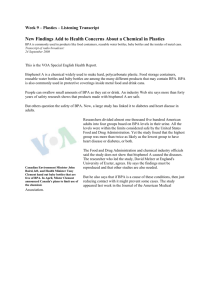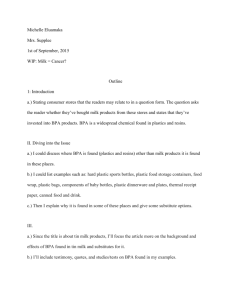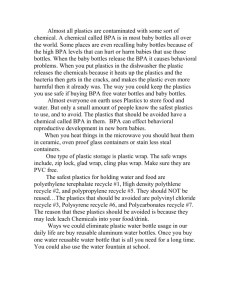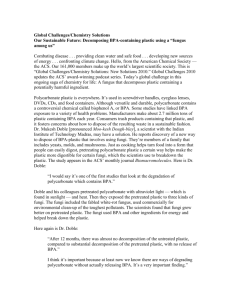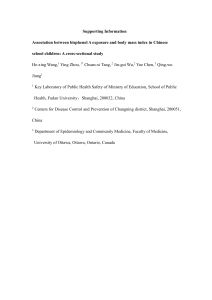NRDC: Chemicals in Plastic Bottles
advertisement
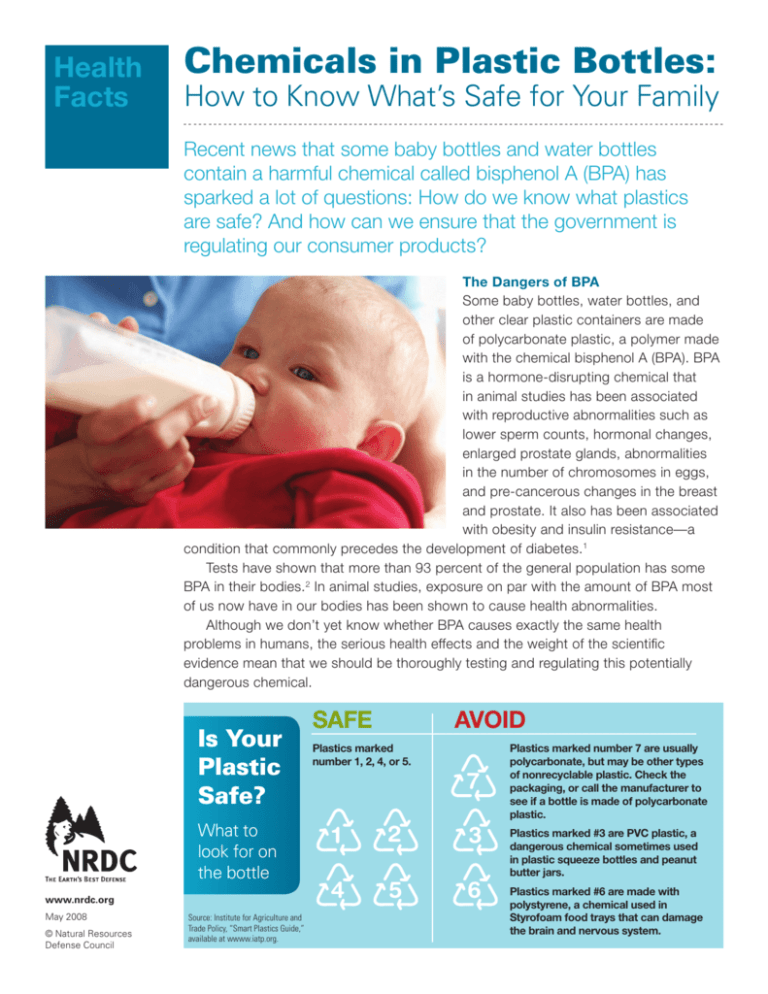
Health Facts Chemicals in Plastic Bottles: How to Know What’s Safe for Your Family Recent news that some baby bottles and water bottles contain a harmful chemical called bisphenol A (BPA) has sparked a lot of questions: How do we know what plastics are safe? And how can we ensure that the government is regulating our consumer products? The Dangers of BPA Some baby bottles, water bottles, and other clear plastic containers are made of polycarbonate plastic, a polymer made with the chemical bisphenol A (BPA). BPA is a hormone-disrupting chemical that in animal studies has been associated with reproductive abnormalities such as lower sperm counts, hormonal changes, enlarged prostate glands, abnormalities in the number of chromosomes in eggs, and pre-cancerous changes in the breast and prostate. It also has been associated with obesity and insulin resistance—a condition that commonly precedes the development of diabetes.1 Tests have shown that more than 93 percent of the general population has some BPA in their bodies.2 In animal studies, exposure on par with the amount of BPA most of us now have in our bodies has been shown to cause health abnormalities. Although we don’t yet know whether BPA causes exactly the same health problems in humans, the serious health effects and the weight of the scientific evidence mean that we should be thoroughly testing and regulating this potentially dangerous chemical. Is Your Plastic Safe? What to look for on the bottle www.nrdc.org May 2008 © Natural Resources Defense Council Source: Institute for Agriculture and Trade Policy, “Smart Plastics Guide,” available at wwww.iatp.org. SAFE AVOID Plastics marked number 1, 2, 4, or 5. Plastics marked number 7 are usually polycarbonate, but may be other types of nonrecyclable plastic. Check the packaging, or call the manufacturer to see if a bottle is made of polycarbonate plastic. 1 2 4 5 7 3 Plastics marked #3 are PVC plastic, a dangerous chemical sometimes used in plastic squeeze bottles and peanut butter jars. 6 Plastics marked #6 are made with polystyrene, a chemical used in Styrofoam food trays that can damage the brain and nervous system. Chemicals in Plastic Bottles: How to Know What’s Safe for Your Family Metal Cans Also Contain BPA Polycarbonate plastic bottles and food containers are just one potential source of the BPA in our bodies. BPA is also used in the epoxy resin that lines the inside of metal food and soda cans. BPA exposure from eating canned food or drinking canned soda is often even higher than exposure from drinking out of a polycarbonate beverage container. BPA leaches out of the can liner into the food or drink, especially when the food is acidic such as tomato-based products or sodas. Government Has Failed to Protect Consumers from Harmful Chemicals Since the 1950s, BPA has been approved for use in food containers—despite the dangers revealed in animal studies and the fact that a similar estrogen chemical, DES, has proven to cause reproductive problems such as cancer and infertility and was removed from the market. Although the Food and Drug Administration (FDA) has reevaluated the chemical since it was first approved, its evaluation only considered two studies—both of which were industry-funded.3 Recently, a U.S. government panel expressed concern for the potential health threats of this chemical, and the FDA is once again evaluating its position. The United States Needs Stronger Protections for Consumer Products Although we don’t yet know exactly how BPA exposure affects human health, the evidence of serious health effects in animals indicates that we should proceed with caution. Unfortunately, the federal government has consistently failed to implement any protective regulatory framework for hormone-disrupting chemicals, despite recommendations from the scientific community since the early 1990s. The lack of BPA safeguards is representative of the broken chemical regulation policy in the United States. Without a system for testing classes of chemicals, such as hormone disrupters, toxics are put on the market as consumer goods before they are fully tested for reproductive effects. With the stakes so high, health agencies should 1) immediately begin comprehensive testing of the health impacts of BPA and other non-pesticide chemicals, and 2) develop a regulatory framework for keeping dangerous materials out of consumer products. 1 Vom Saal et al., “Chapel Hill Bisphenol A Expert Panel Consensus Statement: Integration of Mechanisms, Effects in Animals and Potential to Impact Human Health at Current Levels of Exposure,” Reproductive Toxicology, 2008 August-September, pp. 131-138. 2 Calafat A.M., Ye X., Wong L.Y., Reidy J.A., and Needham L.L., “Exposure of the U.S. Population to Bisphenol A and 4-tertiary-octylphenol: 2003-2004,” Environ Health Perspect, 2008 Jan;116(1):39-44. 3 U.S. House of Representatives, Committee on Energy and Commerce. Letter from Chair John D. Dingell to the FDA, April 4, 2008. What You Can Do to Protect Your Health n If you have a newborn, avoid baby bottles or sippy cups made of polycarbonate plastic. n hoose glass jars and bottles instead of C cans, especially when buying soda, preserved vegetables, or soup. Or opt for frozen vegetables over canned. n uy packaged soups and broth in cardboard B “brick” cartons, which are made of safer materials. n imit your consumption of canned soda and L canned food during pregnancy. n void plastic labeled #7, especially if you are A pregnant or breast-feeding. n on’t allow your children to have dental sealants D made from BPA applied to their teeth, and don’t have these sealants applied to your teeth while you are pregnant. n isit www.SimpleSteps.org to find out more V about what plastic products are safe. Timeline of BPA Research and Testing 1891: BPA is developed. 1930s: Scientists discover that BPA is an artificial estrogen. 1953: BPA is used in polycarbonate plastic, a material used for plastic baby bottles and water bottles. 1993: The EPA sets a safety standard for BPA, but only at very high doses, despite studies showing that even low doses may be linked to cancer, reproductive problems, and other health issues. 1997: FDA finds that BPA leaches from the lining of metal baby formula cans. 1999: Consumer Reports finds that BPA leaches from baby bottles when heated. 2003-2006: Science International, an organization contracting with the National Institutes of Health (NIH), finds that BPA at low doses is safe. It is later discovered that Science International also did work for two creators of BPA-containing products, and NIH fires the group. 2007: An NIH panel of international experts concludes that BPA presents a clear risk to human health. 2008: The House Committee on Energy and Commerce begins investigating BPA. In April, the chairman of the committee calls for the FDA to better regulate BPA in baby and children’s products. Source: The Washington Post, “117 Years of BPA,” April 27, 2008.
